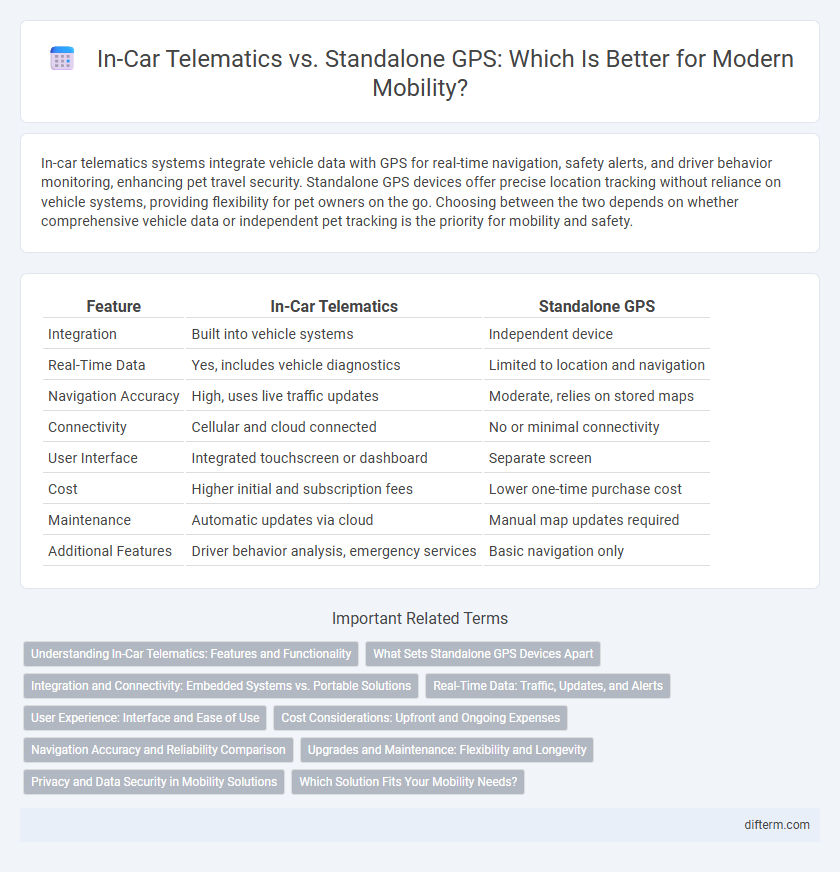In-car telematics systems integrate vehicle data with GPS for real-time navigation, safety alerts, and driver behavior monitoring, enhancing pet travel security. Standalone GPS devices offer precise location tracking without reliance on vehicle systems, providing flexibility for pet owners on the go. Choosing between the two depends on whether comprehensive vehicle data or independent pet tracking is the priority for mobility and safety.
Table of Comparison
| Feature | In-Car Telematics | Standalone GPS |
|---|---|---|
| Integration | Built into vehicle systems | Independent device |
| Real-Time Data | Yes, includes vehicle diagnostics | Limited to location and navigation |
| Navigation Accuracy | High, uses live traffic updates | Moderate, relies on stored maps |
| Connectivity | Cellular and cloud connected | No or minimal connectivity |
| User Interface | Integrated touchscreen or dashboard | Separate screen |
| Cost | Higher initial and subscription fees | Lower one-time purchase cost |
| Maintenance | Automatic updates via cloud | Manual map updates required |
| Additional Features | Driver behavior analysis, emergency services | Basic navigation only |
Understanding In-Car Telematics: Features and Functionality
In-car telematics integrate GPS navigation with real-time vehicle diagnostics, driver behavior analysis, and connectivity features, offering a comprehensive mobility solution beyond standalone GPS. These systems provide dynamic route optimization, safety alerts, and remote monitoring capabilities essential for fleet management and personal vehicle maintenance. Enhanced by data analytics and wireless communication, in-car telematics deliver improved driving efficiency, security, and user experience compared to traditional GPS devices.
What Sets Standalone GPS Devices Apart
Standalone GPS devices offer dedicated satellite navigation with high-accuracy positioning independent of cellular networks, ensuring reliable routing even in remote or low-signal areas. These devices often include features like preloaded maps, customizable route options, and longer battery life without relying on the car's power supply. Unlike in-car telematics systems, standalone GPS units provide consistent performance without the need for software updates or internet connectivity.
Integration and Connectivity: Embedded Systems vs. Portable Solutions
Embedded in-car telematics systems offer seamless integration with a vehicle's internal networks, providing real-time data exchange that enhances navigation, diagnostics, and safety features. In contrast, standalone GPS devices function independently, often requiring manual updates and lacking connectivity with other vehicle systems. The integrated connectivity of embedded systems supports advanced functionalities like traffic-aware routing and remote vehicle monitoring, which portable solutions cannot match due to limited communication capabilities.
Real-Time Data: Traffic, Updates, and Alerts
In-car telematics systems provide real-time traffic data, dynamic route updates, and immediate alerts that standalone GPS devices often lack, enhancing navigation accuracy and driving safety. These systems leverage connected networks to deliver live incident reports, road closures, and weather conditions, optimizing travel time and reducing congestion. The integration of telematics enables personalized driving insights and predictive analytics, surpassing the static functionality of traditional GPS units.
User Experience: Interface and Ease of Use
In-car telematics systems offer a seamless user experience with integrated interfaces designed for minimal driver distraction, providing real-time data on vehicle diagnostics, navigation, and connectivity all within the dashboard. Standalone GPS devices often feature dedicated, simplified screens focused solely on navigation, which can be easier for users seeking straightforward route guidance without additional vehicle information. The in-car telematics interface typically supports voice commands and touchscreen controls embedded into the vehicle's system, enhancing ease of use compared to standalone GPS units that may have less sophisticated input options.
Cost Considerations: Upfront and Ongoing Expenses
In-car telematics systems typically involve higher upfront costs due to integrated hardware, software, and installation fees compared to standalone GPS devices. Ongoing expenses for telematics include subscription plans, data charges, and maintenance that support real-time data transmission and extended functionalities. Standalone GPS units usually incur lower ongoing costs, primarily limited to occasional map updates and basic maintenance without the need for continuous connectivity services.
Navigation Accuracy and Reliability Comparison
In-car telematics systems offer superior navigation accuracy and reliability compared to standalone GPS devices by integrating real-time traffic updates, vehicle diagnostics, and sensor data for precise route adjustments. These advanced systems leverage continuous connectivity and machine learning algorithms to adapt to changing road conditions and optimize travel time. Standalone GPS units, while effective for basic navigation, often lack dynamic data integration, leading to less accurate routing and potential delays.
Upgrades and Maintenance: Flexibility and Longevity
In-car telematics systems offer automatic software upgrades and real-time diagnostics, enhancing vehicle performance and security without manual intervention, unlike standalone GPS devices that often require periodic manual updates and hardware replacements. The integration of telematics with vehicle systems ensures compatibility with future technological advancements, extending the system's longevity and reducing maintenance costs. Conversely, standalone GPS units tend to have limited upgrade paths, leading to shorter lifespans and increased risk of obsolescence.
Privacy and Data Security in Mobility Solutions
In-car telematics systems offer enhanced privacy controls by integrating data encryption and anonymization directly within the vehicle's ecosystem, reducing exposure risks compared to standalone GPS devices that often transmit raw location data externally. These telematics platforms leverage secure communication protocols such as TLS and adhere to strict regulatory frameworks like GDPR to safeguard user information. Deploying in-car telematics improves data security by minimizing third-party access and enabling real-time monitoring and threat detection, which standalone GPS solutions typically lack.
Which Solution Fits Your Mobility Needs?
In-car telematics systems provide comprehensive connectivity by integrating navigation, vehicle diagnostics, and real-time traffic updates, enhancing safety and efficiency beyond standalone GPS capabilities. Standalone GPS devices primarily offer reliable location tracking and route guidance without additional telematics features, making them suitable for users seeking straightforward navigation. Choosing between these solutions depends on your mobility needs: in-car telematics is ideal for drivers requiring multi-functional vehicle management, while standalone GPS serves those focused solely on precise navigation.
in-car telematics vs standalone GPS Infographic

 difterm.com
difterm.com